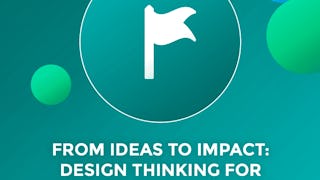Human-centered design is an approach that focuses on human needs, goals, and experiences to frame problems, develop solutions, and coordinate resources. Through a series of videos, activities, and reflection, learners will develop an appreciation for the value and impact of human-centered design as well as begin to understand what investment is required to practice it well. The course prepares learners to collaborate with human-centered design practitioners and deepen their own practice.



(12 reviews)
(12 reviews)
Skills you'll gain
Details to know

Add to your LinkedIn profile
10 assignments
See how employees at top companies are mastering in-demand skills


Earn a career certificate
Add this credential to your LinkedIn profile, resume, or CV
Share it on social media and in your performance review

There are 5 modules in this course
Human-centered design is an approach that focuses on human needs, goals, and experiences to frame problems, develop solutions, and coordinate resources. Through a series of hands-on exercises and group reflection, learners will develop an appreciation for the impact human-centered design can make and begin to understand what investment is required to practice it well. This course is relevant to anyone who works with humans to achieve things for humans, regardless of title or field, and prepares them to collaborate with human-centered design practitioners and deepen their own practice.
What's included
1 video6 readings3 assignments1 discussion prompt
Learners explore how to identify needs by gathering data from people and interpreting that data. After understanding the cost of solving the wrong problem, learners discover what kind of data is valuable to gather and what methods might be best suited for gathering that data. Learners then have a hands-on experience gathering that data themselves. Through the gathered data, learners collaborate regarding needs to be interpreted and methods for doing so. Using one of the methods, learners arrive at a problem statement to address in the next module. Finally, learners use their naïve solution and individual goals to reflect on the value of design thinking and how it might apply to their daily work.
What's included
1 video3 readings2 assignments
Learners explore opportunities by facilitating generation and iteration of ideas. After learning about the relationship between psychological safety, creativity, and evaluation, they are shown methods for facilitating psychological safety for idea generation and prioritization. Learners then use these methods to generate and prioritize ideas. Learners will consider the undesirable cost of building the wrong solution and how strategic failure can reduce those costs. Learners also explore methods of strategic failure that identify and fill gaps in solutions, then apply those to their prioritized idea to refine it. Finally, learners use their naïve solution and individual goals to reflect on the value of design thinking and how it might apply to their daily work.
What's included
1 video4 readings2 assignments
Learners will understand how make their ideas happen once they have the right one. They reflect on their change in thinking since the beginning of the course and reflect on what was formative in this growth. Learners practice how to identify stakeholders. They also learn why stakeholders are important, and what stakeholders’ concerns might be. After mapping out stakeholders and diving deeper into a specific stakeholder’s perspective, learners analyze the utility of narratives and how to make a powerful narrative by considering human needs and organizational constraints. With that information, learners create and present a narrative aimed at their aforementioned specific stakeholder. Learners are presented with an overview to review ideas and strategies they have explored and experienced in the four modules, and then do a final reflection on how these may be applied to their daily work.
What's included
1 video4 readings2 assignments
In this module, learners consider how to analyze and guide the collaborative process to ensure diverse perspectives contribute to achieving a shared goal. Learners practice coordinating action between various stakeholders, who each have unique expertise and viewpoints.
What's included
2 videos4 readings1 assignment1 peer review
Instructor

Offered by
Explore more from Business Essentials


University of California San Diego


Northwestern University


IE Business School


Fractal Analytics
Why people choose Coursera for their career




Learner reviews
12 reviews
- 5 stars
41.66%
- 4 stars
41.66%
- 3 stars
8.33%
- 2 stars
8.33%
- 1 star
0%
Showing 3 of 12
Reviewed on Jun 25, 2024
Really insightful and beginner friendly. You learn better ways to navigate problem solving and methods to reach good solutions.
New to Business Essentials? Start here.

Open new doors with Coursera Plus
Unlimited access to 10,000+ world-class courses, hands-on projects, and job-ready certificate programs - all included in your subscription
Advance your career with an online degree
Earn a degree from world-class universities - 100% online
Join over 3,400 global companies that choose Coursera for Business
Upskill your employees to excel in the digital economy
Frequently asked questions
Access to lectures and assignments depends on your type of enrollment. If you take a course in audit mode, you will be able to see most course materials for free. To access graded assignments and to earn a Certificate, you will need to purchase the Certificate experience, during or after your audit. If you don't see the audit option:
The course may not offer an audit option. You can try a Free Trial instead, or apply for Financial Aid.
The course may offer 'Full Course, No Certificate' instead. This option lets you see all course materials, submit required assessments, and get a final grade. This also means that you will not be able to purchase a Certificate experience.
When you purchase a Certificate you get access to all course materials, including graded assignments. Upon completing the course, your electronic Certificate will be added to your Accomplishments page - from there, you can print your Certificate or add it to your LinkedIn profile. If you only want to read and view the course content, you can audit the course for free.
You will be eligible for a full refund until two weeks after your payment date, or (for courses that have just launched) until two weeks after the first session of the course begins, whichever is later. You cannot receive a refund once you’ve earned a Course Certificate, even if you complete the course within the two-week refund period. See our full refund policy.
More questions
Financial aid available,


